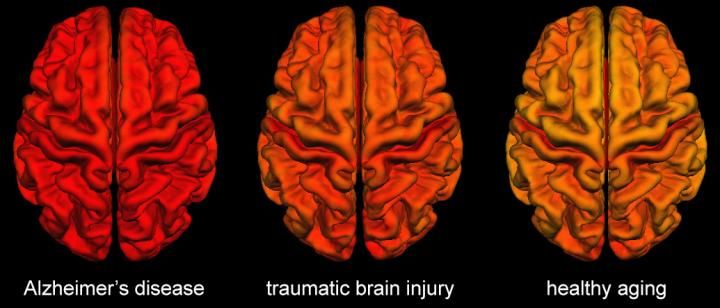MRI Brain Scans Show Similarities Between TBI and Alzheimer’s
Scans show significant similarities between gray and white brain matter changes in patients with both conditions.
Brain changes that occur in people who have mild traumatic brain injuries (TBI) have significant similarities on MRI with alterations detected in the brains of patients with Alzheimer’s disease.
These findings, published in GeroScience, could allow providers to identify patients who are at high risk for developing Alzheimer’s, said a team of researchers from the University of Southern California (USC).
“These findings are the first to suggest that cognitive impairment following a traumatic brain injury is useful for predicting the magnitude of Alzheimer’s-like brain degradation,” said study author Adrei Irimia, assistant professor of gerontology, neuroscience, and biomedical engineering at the USC Leonard Davis School of Gerontology and the USC Viterbi School of Engineering. “The results may help health professionals to identify TBI victims who are at greater risk for Alzheimer’s disease.”
Related Content: TBI Patient Outcomes Could Improve with Earlier MRI
More than 1.7 million Americans are affected by a TBI annually, and 15 percent have a TBI history. Older people are approximately three times as likely as other age groups to sustain a TBI, and the resulting impacts on their cognitive function are particularly severe, the team said. To date, however, few studies have looked into whether TBI can actually change brain trajectories toward Alzheimer’s, especially at older ages.
By using MRI and machine learning, the researchers investigated whether comparing TBI and Alzheimer’s brain change patterns could not only unearth similarities in their degenerative trajectories, but if it could also reveal the brain atrophy characteristics that could predict Alzheimer’s risk about TBI.
Displayed is the cortical thickness for each group studied (Alzheimer's disease, traumatic brain injury and healthy aging) after mapping each participant's cortical surface to an atlas average. The color scale ranges from bright red (thinner cortex) to yellow (thicker cortex). Healthy participants have the thickest cortex, whereas patients with Alzheimer's disease exhibit pronounced cortical thinning, which is a hallmark of the disease. As expected, TBI patients fall in between the two groups based on their typical cortical thickness. This reflects their faster rate of cortical thinning, which is accelerated by injury and by subsequent pathological processes. Such accelerated cortical thinning is illustrative of TBI patients' higher risk of neurodegeneration along Alzheimer's disease-like trajectories.
CREDIT
Kenneth Rostowsky, USC

For their study, the team examined MRI scans from 33 participants with TBI due to a fall, 66 patients who had received an Alzheimer’s diagnosis, and 81 healthy controls who had neither TBI nor Alzheimer’s. In addition to analyzing the brain scans, the team also built computer-generated models that could compare dozens of brain structures, rendering a map of similarities and differences between the three groups.
According to their investigation, the researchers discovered reduced cortical thickness – associated with reduced attention, memory, and verbal fluency – in multiple brain areas of both TBI and Alzheimer’s patients when compared to healthy individuals. These reductions are also linked to lowered decision-making abilities, as well as difficulties in adapting to new situations and integrating new information.
In addition, Irimia’s team also discovered distinct similarities in how gray and white brain matter degrade after both TBI and Alzheimer’s. For gray matter, which contains the brain’s neuron cell bodies and short-range connections, changes to the temporal lobes and orbitofrontal cortices -- which are involved with memory and decision-making, respectively – had the most similarities.
Related Content: MRI-Determined Brain Volume Can Predict PTSD
With white matter, the researchers said they found the most similarities in the fornix, corpus callosum, and corona radiata. These areas are most involved with memory, information exchange between the brain’s hemispheres, and limb movement.
Using the machine learning strategies, as well as the results of cognitive tests conducted shortly after mild TBI injuries, the team was also able to accurately predict the severity of Alzheimer’s-like brain changes observed during the chronic stage of mild TBI.
The team noted that, while their findings do not cement a cause-and-effect relationship between TBI and Alzheimer’s, they do add to the evidence base that the conditions share common trajectories.
For more coverage based on industry expert insights and research, subscribe to the Diagnostic Imaging e-Newsletter here.
New MRI Research Explores Links Between Waist-to-Hip Ratio and Memory in Aging
March 13th 2025Researchers found that a higher waist-to-hip ratio in midlife was associated with higher mean diffusivity in 26 percent of total white matter tracts in the cingulum as well as the superior and inferior longitudinal fasciculus.
Meta-Analysis Shows No Difference Between bpMRI and mpMRI in Ruling Out csPCa
March 6th 2025In an 18-study meta-analysis involving over 4,600 patients, researchers found that bpMRI and mpMRI had equivalent pooled negative predictive value (NPV) of 92 percent for clinically significant prostate cancer (csPCa).